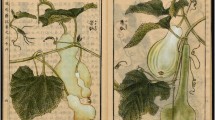Abstract
The inflorescence of Aponogeton distachyos, an endemic Cape South African aquatic herb, known as waterblommetjie, has been a traditional wild-gathered vegetable. This plant has been brought into cultivation as a food crop during the past twenty years. The reasons for its domestication were the loss and decline in wild populations because of herbicide runoff from agriculture, urban expansion that reduced the plant’s habitat, and overcollection. Domestication also began because a pop song, celebrating this vegetable as an Afrikaans cultural symbol, started a food fad that greatly increased demand. Waterblommetjie cultivation, widespread marketing, and the general popularity of this unique food continues in the Mandela Era of South Africa.
Résumé
La inflorecencia de Aponogeton distachyos, una hierba ácuatica endémica al Cabo de Buena Esperanza, Africa, conocido como waterblommetjie, ha sido una vegetal silvestere tradicional. La planta se ha adoptada para 1a cultivatión dentro los últimos veinte años. Las razones por domesticarla fueron 1a perdida y el declino de las poblaciones silvestres por cause del escurrimiento de los herbicidas de áreas agríciolas, 1a expansión urbana 1a qual redujo el área de hábitat del la planta, y su cosecha excesiva. Además, su domesticatión empezó porque una canción popular 1a cual celebró esta verdura como un símbolo cultural africaans empezó una moda en 1a comid 1a cual aumentó mucho la demanda. La cultivateón de waterblommetjie, el mercado extendido, y la popularidad general de esta única comida continuan durante la era de Mandela en Sudáfrica.
Similar content being viewed by others
Literature Cited
Anderson, E. 1952. Plants, man, and life. Univ. California Press, Berkeley.
Bailey, L. H., and E. Z. Bailey and the staff of the Liberty Hyde Bailey Hortorium (Cornell University). 1976. Hortus Third, a concise dictionary of plants cultivated in the United States and Canada. MacMillan, New York.
Bond, P.,and P. Goldblatt. 1984. Plants of the Cape Flora, a descriptive catalogue. Journal of South African Botany Supplementary vol. no. 13.
Fox, F. W, and M. E. Norwood Young. 1982. Food from the veld. Delta Books, Craighall, South Africa.
Gerber, H. 1957. Traditional cookery of the Cape Malays. A.A. Balkema, Amsterdam and Cape Town.
Gossen, H. 1981. Cape water flowers bloom. South African Panorama (South Africa), Dec. 19-23.
Hedrick, U. P. 1919. Sturtevant’s edible plants of the world. Dover, New York.
Hooker, W. J. 1831. Botanical miscellany, vol. 2. London.
Louw, M. 1981. Waterblommetjies. Cumboeke Roodepoort, Pretoria, South Africa [in Afrikaans].
Mabberley, D. J. 1993. The plant book. Cambridge Univ. Press, Cambridge, U.K.
McVeigh, S. 1989. Viable waterblommetjie. Farmer’s Weekly (South Africa), April 14, pp. 18-19.
-. 1994. Dedicated to quality on the shelf. Farmer’s Weekly (South Africa), May 20, pp. 48-49. {au{fnPaxton}, {gnJ.}},and {au{gnP.} {fnLindley}} (revised by T. Baines). {dy1883}. {btPaxton’s flower garden. Vol. 2}. {pmCassell and Co. Ltd.}, {plLondon}.
Peters, C. P., E. M. O’Brien, and R. B. Drummond. 1992. Edible wild plants of Sub-Saharan Africa. Royal Botanical Gardens, Kew.
Robins, M. 1994. The Cape cookbook. Chameleon Press, Diep River, South Africa.
Schmida, A., and R. H. Whittaker. 1981. Pattern and biological microsite effects in two shrub communities, Southern California. Ecology 62:234–351.
Thunberg, C. P. 1796. Travels in Europe, Africa, and Asia, made between the years 1770 and 1779. 3rd. ed., vol. 2–4, London.
Van Bruggen. 1985. Monograph of the genusAponogeton (Aponogetonaceae). Bibliotheca Botanica (Stuttgart, Germany) 33 (137):52,53,69.
Viljoen, B. 1994. Waterblommetjies for extra cash. Farmer’s Weekly (South Africa), Sept. 9, pp. 44–45.
Watt, J. M., and M. G. Breyer-Brandwijk. 1962. Medical and poisonous plants of southern and eastern Africa. 2nd ed. Livingstone, Edinburgh and London.
Zohary, D., and M. Hopf. 1994. Domestication of plants in the Old World. Oxford Univ. Press, Oxford.
Author information
Authors and Affiliations
Rights and permissions
About this article
Cite this article
Pemberton, R.W. Waterblommetjie (Aponogeton distachyos, aponogetonaceae), a recently domesticated aquatic Food Crop in Cape South Africa with unusual origins. Econ Bot 54, 144–149 (2000). https://doi.org/10.1007/BF02907818
Received:
Accepted:
Issue Date:
DOI: https://doi.org/10.1007/BF02907818




